Spanish cuisine offers a rich diversity of flavors and ingredients. Whether you’re a seasoned chef or just starting, trying out Spanish recipes can bring a new and exciting twist to your cooking routine.
You’ll discover dishes that are both simple to prepare and packed with flavor, capturing the essence of Spain’s culinary heritage. From savory tapas to hearty stews, these recipes will help you explore and enjoy the vibrant tastes of Spanish food at home.
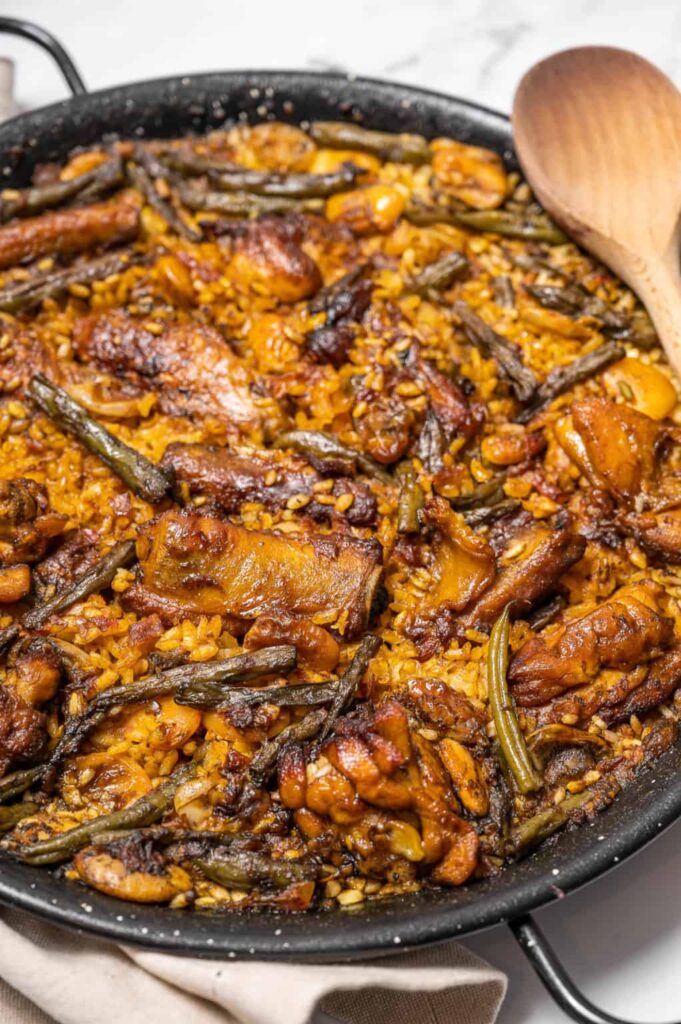
1) Paella Valenciana
Paella Valenciana is a classic Spanish dish that originated in Valencia. It’s known for its rich flavors and vibrant presentation.
You start by heating olive oil in a wide, shallow pan called a paella pan. Add chicken and rabbit pieces. Cook until browned.
Next, stir in green beans, butter beans, and garrofó beans. Let them cook for a few minutes.
Add grated tomatoes and paprika. Stir everything together gently.
Then, you add water to the pan. Use a toothpick to measure the level. This ensures you have the right amount of liquid.
Once the water boils, sprinkle in the paella rice. Stir briefly to spread it evenly, then let it cook without stirring more.
The final step is letting the paella rest. Cover it with a clean kitchen towel for about 5 minutes. This allows the flavors to meld.
Serve your Paella Valenciana from the pan with fresh lemon wedges for extra zest. This dish is perfect for family gatherings and brings an authentic taste of Spain to your table.
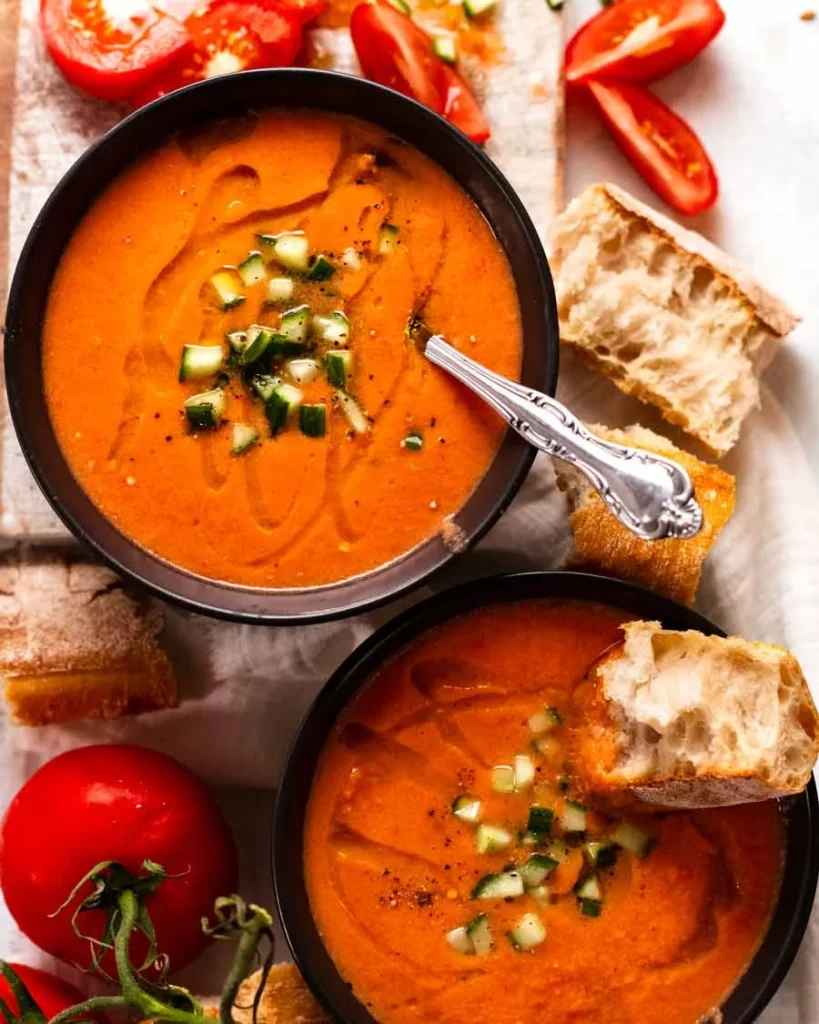
2) Gazpacho
Gazpacho is a cold soup that hails from Spain, known for its refreshing taste. It’s perfect for hot summer days.
To make gazpacho, start with ripe tomatoes as they provide the base for the soup. You’ll also need cucumber, green bell pepper, red onion, and garlic.
Chop these vegetables roughly. Then, blend them until smooth. Add a slice of bread soaked in water to give the soup a thicker texture.
Sherry vinegar and extra virgin olive oil are essential for the traditional flavor. Don’t forget to add cold water and a pinch of sea salt. Blend everything again until well mixed.
Refrigerate the soup for at least 2 hours before serving. This allows the flavors to meld and enhances the refreshing quality.
Serve the gazpacho chilled, garnished with additional chopped veggies or a drizzle of olive oil. Some toasted bread on the side makes a perfect accompaniment.
Enjoy this classic Spanish dish for a light appetizer or a cooling snack during warm weather.
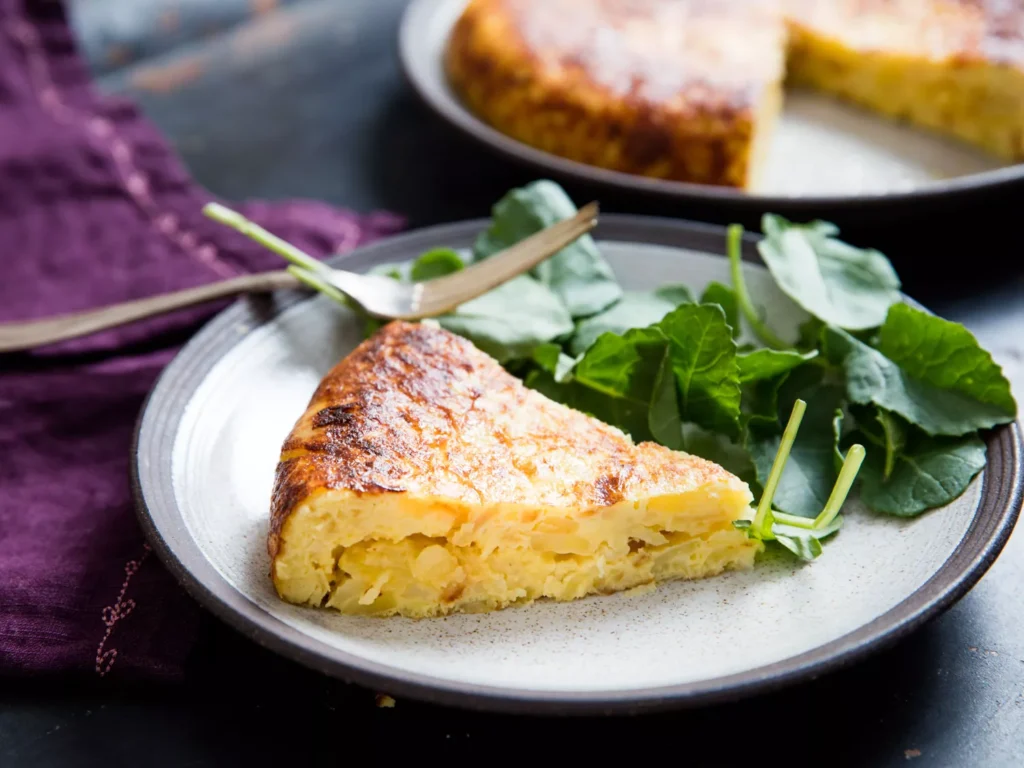
3) Tortilla Española
Tortilla Española, also known as Spanish Omelette, is a popular dish in Spain. It is made with simple ingredients: potatoes, onions, eggs, and olive oil.
Start by slicing the potatoes into thin disks. You can peel them or leave the skin on. Cook the potatoes in a skillet with olive oil over medium heat until they are tender.
In a separate pan, cook sliced onions in olive oil until they turn golden brown and soft. Drain the cooked potatoes and let them cool slightly before mixing them with the onions.
Beat the eggs in a large bowl until smooth. Add the cooled potatoes and onions to the eggs. Stir gently to combine everything well.
Heat a skillet with some reserved olive oil over medium heat. Pour the egg, potato, and onion mixture into the skillet. Press gently to even out the top.
Reduce the heat to medium-low. Cook the tortilla until the edges start to set, then carefully flip it onto a plate. Slide the tortilla back into the pan to cook the other side for a few more minutes.
Serve your Tortilla Española warm or at room temperature. It can be enjoyed as a main dish or as a tapa.

4) Patatas Bravas
Patatas Bravas is a popular Spanish dish featuring fried potatoes topped with a spicy sauce. This dish is often served as tapas in bars and restaurants across Spain. It’s loved for its crispy texture and bold flavors.
To make Patatas Bravas, start by cutting the potatoes into bite-sized cubes. Heat oil in a pan or skillet to 350°F (176°C). Fry the potatoes until they are golden and crispy.
For the bravas sauce, mince a clove of garlic and finely chop a spicy pepper. Heat a tablespoon of olive oil in a pan and sauté the garlic and pepper. Add smoked paprika and tomato paste to the pan, cooking until the sauce thickens.
You can also make a garlic mayo aioli to complement the dish. Mix mayonnaise with finely grated garlic, lemon juice, olive oil, salt, and black pepper to make a creamy sauce.
After the potatoes are done frying, drain them on a paper towel-lined plate. Sprinkle with salt, then drizzle with the bravas sauce. For extra flavor, add a dollop of the garlic mayo aioli on the side. Serve immediately while the potatoes are hot and crispy.
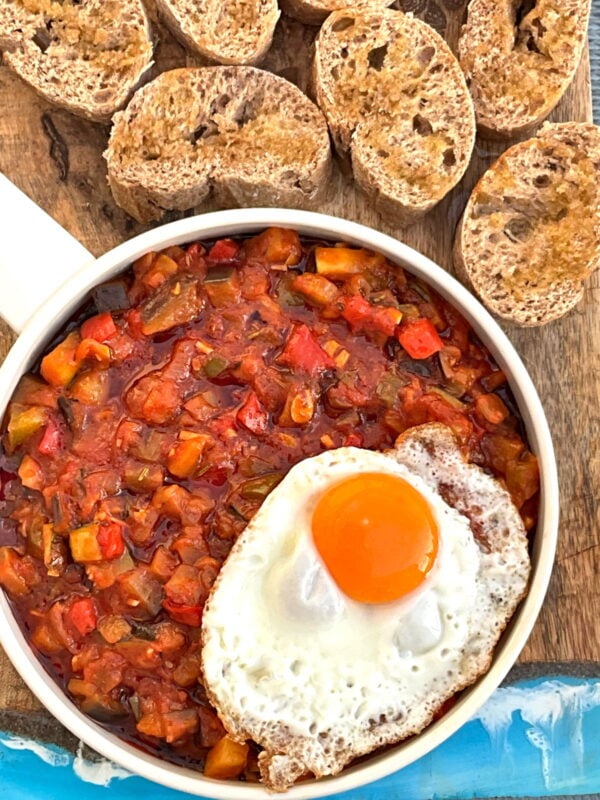
5) Pisto
Pisto is a traditional Spanish vegetable stew. It’s quite similar to ratatouille, made from fresh and simple ingredients. You’ll need bell peppers, zucchini, tomatoes, onions, eggplant, and garlic.
Start by thinly slicing the garlic and chopping the other vegetables into bite-sized chunks. Cook each vegetable separately in olive oil until they are soft and lightly browned. This helps to bring out their flavors.
Once the vegetables are cooked, combine them in a large pot. Allow them to simmer together for about 30 minutes. Adjust the seasoning with salt and a bit of sugar if the tomatoes are too acidic.
Pisto is often served with a fried egg on top and some crusty bread. It’s a tasty way to enjoy the flavors of fresh, summer vegetables. You can enjoy it as a main dish or a side.
This dish is not just delicious but also nutritious. It’s packed with vitamins and minerals from the vegetables. Pisto is a perfect example of simple, wholesome Spanish cooking.
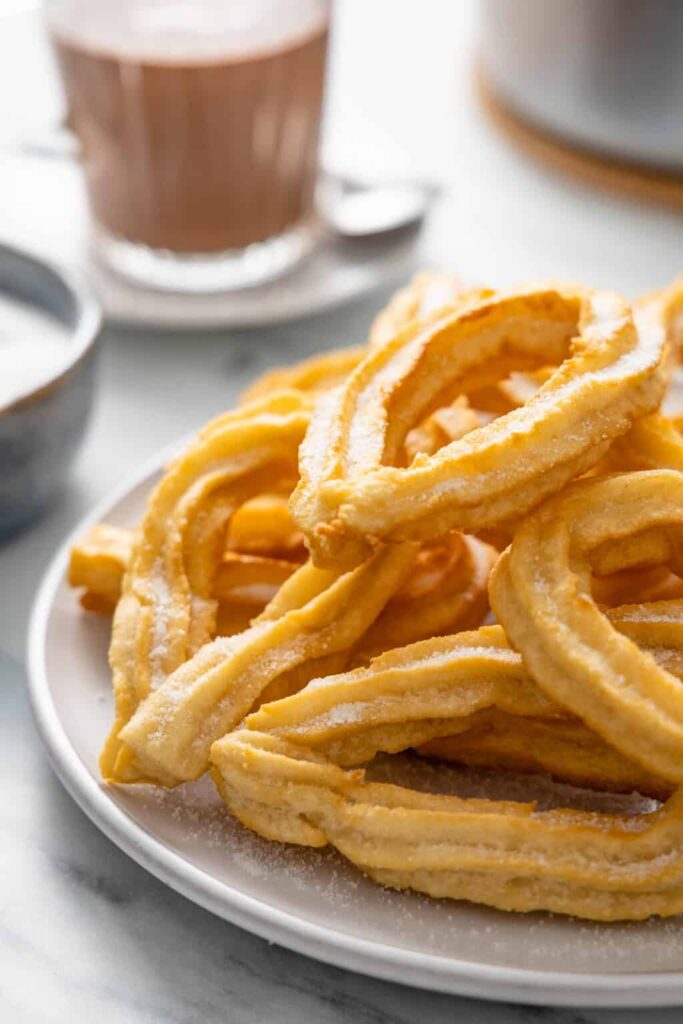
6) Churros con Chocolate
Churros con Chocolate is a beloved Spanish treat often enjoyed for breakfast or as a dessert. This dish pairs crispy fried dough with thick, rich chocolate for dipping.
To make churros, start by heating water, salt, sugar, and butter in a saucepan until it boils. Add sifted flour and stir until you form a dough that doesn’t stick to the sides.
Once the dough cools slightly, transfer it into a piping bag fitted with a star-shaped nozzle. Pipe 6-inch strips of dough into hot oil and fry until golden brown. Drain the churros on a paper towel-lined plate.
For the chocolate sauce, mix milk and cornstarch in a small bowl. Heat the remaining milk with chopped chocolate in a saucepan until melted and smooth. Stir in the cornstarch mixture and cook until thick.
Serve the churros warm alongside the chocolate sauce. Dip each churro into the chocolate for a delightful combination of crunchy and creamy textures.

7) Croquetas
Croquetas are a famous Spanish dish that you can easily enjoy as a snack or appetizer. They are small, breaded and fried rolls usually filled with a creamy mixture. The most popular type is ham croquetas, but you can also find varieties with chicken, fish, or vegetables.
To start making croquetas, you will need to prepare a béchamel sauce. Heat butter and oil in a pan, then add finely diced onions and sauté them until they start to color. Mix in flour and cook for a few minutes, then slowly add milk while stirring to get a thick sauce.
Next, add your desired filling, such as diced Serrano ham, and cook for a minute. Season with salt, pepper, and a pinch of nutmeg. Let the mixture cool, then shape it into small rolls or balls.
Coat each croqueta with beaten egg and breadcrumbs. Chill them in the fridge for about an hour to help them set. When ready to cook, heat oil in a deep pan and fry the croquetas in batches until golden brown. Serve them hot and enjoy with a salad or dipping sauce.
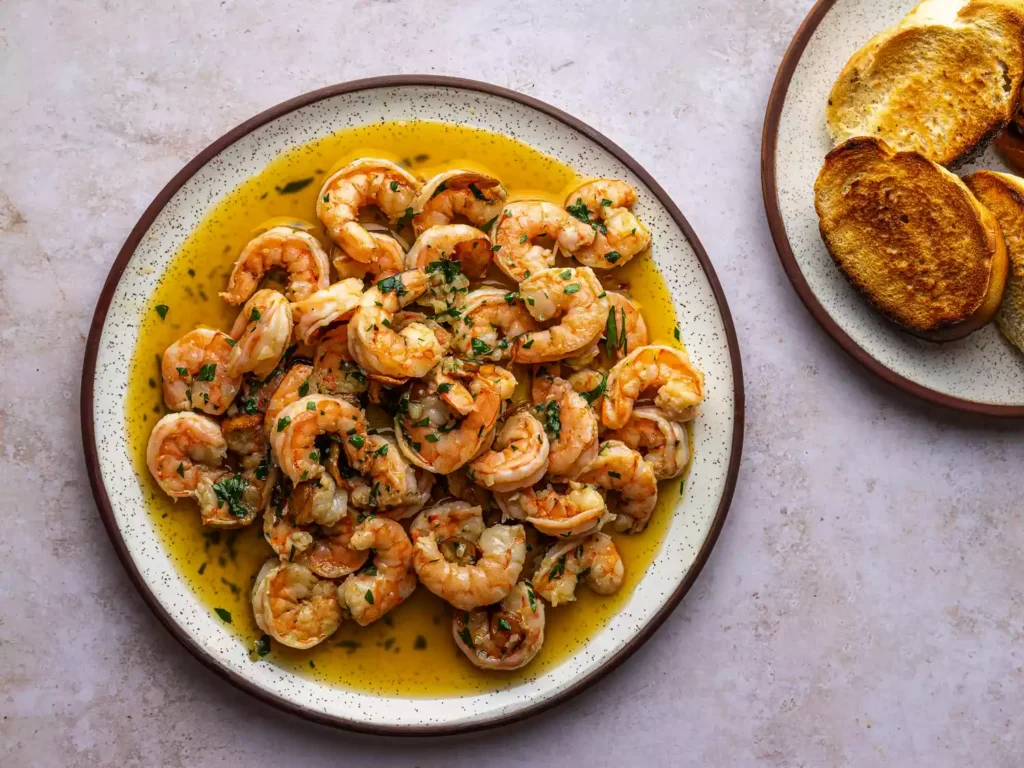
8) Gambas al Ajillo
Gambas al Ajillo is a popular Spanish dish featuring succulent shrimp cooked with garlic and olive oil.
Start by peeling and deveining the shrimp. Pat them dry with paper towels, then season with salt and black pepper.
Heat extra virgin olive oil in a skillet over medium heat. Add thinly sliced garlic and cook until it turns golden, but be careful not to burn it.
For a bit of heat, you can add red pepper flakes or small dried cayenne peppers.
Once the garlic is fragrant, add the shrimp to the skillet. Cook them, turning occasionally, until they start to curl and turn pink, but make sure they are not overcooked.
Some recipes suggest adding a splash of white wine or paprika for extra flavor.
Serve Gambas al Ajillo hot, often with a side of crusty bread to soak up the flavorful oil.
This dish is a staple in Spanish cuisine, especially enjoyed in tapas bars.

9) Pollo al Ajillo
Pollo al Ajillo is a classic Spanish dish that highlights the flavors of garlic and chicken. It’s simple to make and packed with taste.
Start by preparing your ingredients. You’ll need chicken pieces, garlic cloves, olive oil, white wine, bay leaves, salt, and pepper.
Begin by peeling and slicing most of the garlic cloves. Crush one clove and set it aside.
In a large saucepan, heat olive oil over medium heat. Add the crushed garlic to infuse the oil with flavor.
Season the chicken pieces with salt and pepper. When the oil is hot, add the chicken to the pan. Cook until the chicken is golden brown on all sides.
Next, add the sliced garlic to the pan. This enhances the garlic flavor in the dish.
Pour in white wine and a bit of water, then add the bay leaves. Cover the pan with a lid and let it simmer over low heat for about 35 minutes.
Make sure to baste the chicken occasionally with the sauce. Flip the chicken halfway through cooking to ensure it cooks evenly.
When the chicken is tender and cooked through, it’s ready to be served. Pollo al Ajillo pairs well with potatoes or a side of your choice. Enjoy this savory and aromatic dish that brings a taste of Spain to your table.
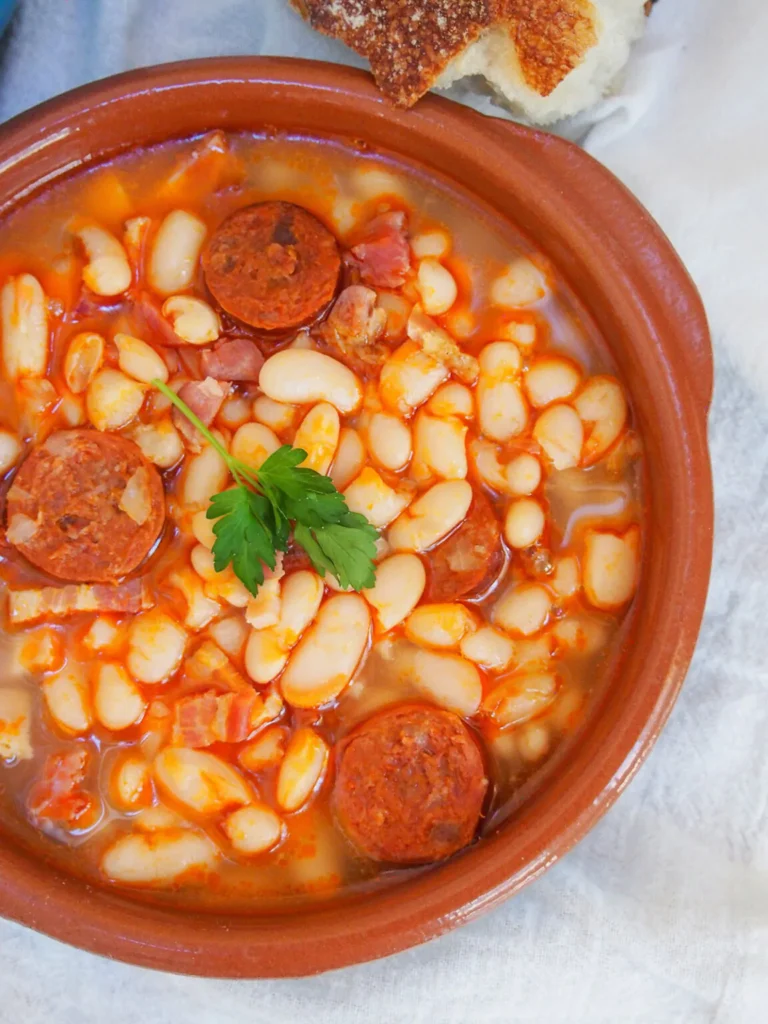
10) Fabada Asturiana
Fabada Asturiana is a hearty Spanish bean stew from the Asturias region. This dish is known for its rich flavors and warming qualities, making it a favorite in cooler weather.
To start, you need to soak white beans in water overnight. This helps soften the beans and makes them easier to cook the next day. Cover the beans with water and let them sit.
Next, drain and rinse the beans. Place them in a large pot with garlic, onion, chicken stock, and various meats like chorizo and morcilla. Bring everything to a boil, then reduce the heat and let it simmer.
As the stew simmers, make sure to skim off any foam that forms at the top. This foam usually comes from the fat in the meats, and removing it helps keep the stew clear and tasty.
Add seasonings like saffron and smoked paprika for extra flavor. These ingredients are key to the unique taste of Fabada Asturiana. Let the stew cook on low heat for 1.5 to 3 hours, ensuring that the beans are tender and the flavors are well blended.
Fabada Asturiana is a fantastic dish to enjoy with family and friends. Its rich taste and comforting texture make it a standout in Spanish cuisine.
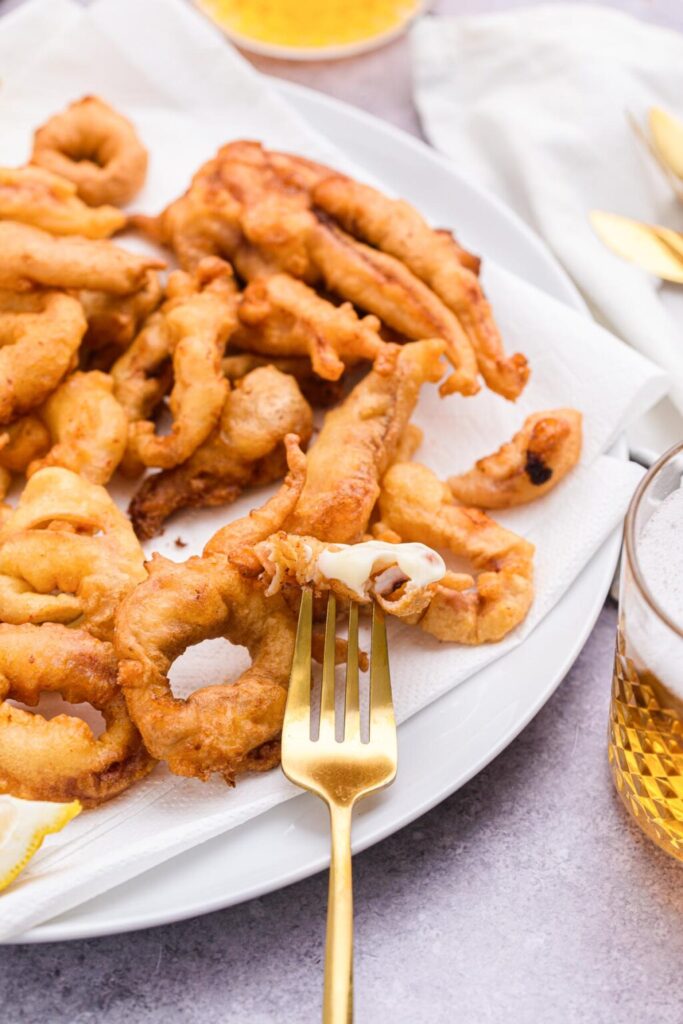
11) Calamares a la Romana
Calamares a la Romana, or fried calamari, is a popular Spanish dish. You’ll love the crispy texture of the fried squid rings, perfect as a tapas dish or appetizer.
First, cut the squid bodies into rings about 1-1.5 cm wide. You can also slice the tentacles into smaller pieces.
Next, prepare the batter. In a bowl, mix flour, salt, baking powder, and eggs. Add some sparkling water to create a smooth, semi-liquid paste.
Heat vegetable oil or olive oil in a frying pan. Make sure the oil is hot but not smoking.
Put the flour and a bit of salt into a plastic bag. Place the squid rings in the bag and shake to coat them evenly.
Dip the floured squid rings into the batter. Carefully place them in the hot oil. Fry the squid until they are golden brown on all sides, turning them as needed to cook evenly.
Once fried, place the calamari on paper towels to drain excess oil. Serve your Calamares a la Romana hot with lemon wedges. The lemon adds a refreshing tang that complements the fried squid perfectly.
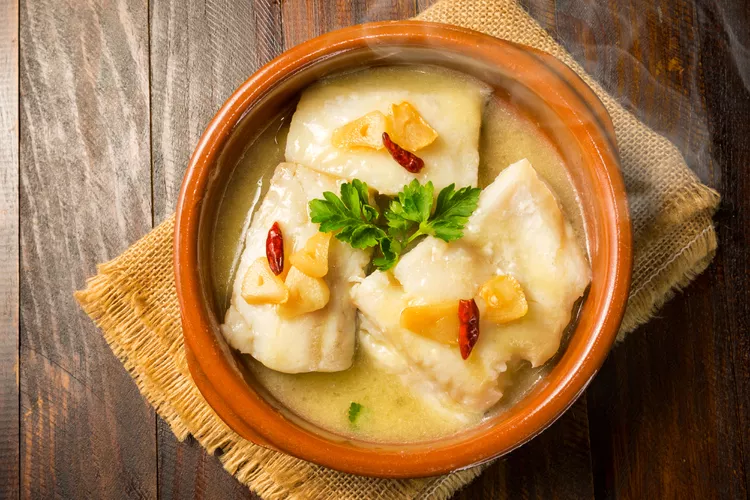
12) Bacalao al Pil Pil
Bacalao al Pil Pil is a classic Spanish dish featuring salted cod cooked with garlic and chili. You start by soaking the salt cod in water for at least 8 hours to remove the excess salt. Don’t forget to change the water twice during this process.
Once the fish is ready, heat a fair amount of olive oil on medium heat. Add sliced garlic and chili peppers, and sauté until the garlic turns golden brown. Be sure not to let the oil get too hot to avoid burning the garlic.
Now, place the cod fillets in the pan, skin side down. Using a circular motion, move the pan to help the sauce emulsify. Keep the heat low to release the natural oils from the cod, which will thicken the sauce.
Continue this circular motion until the sauce transforms into a smooth, silky texture. This may take some time, but patience is key for the best Bacalao al Pil Pil. Once thickened, remove the dish from heat and let it cool slightly. Enjoy this flavorful Spanish dish with some crusty bread for dipping into the rich, garlic-infused sauce.

13) Empanada Gallega
Empanada Gallega is a savory pie from the Galicia region in Spain. This dish features a flaky pastry filled with a rich mixture of vegetables, fish, or meat. It’s a perfect blend of flavors wrapped in a golden crust.
Start by making the dough. You’ll need flour, olive oil, water, and a pinch of salt. Knead these ingredients until they form a smooth, elastic dough. Let it rest while you prepare the filling.
For the filling, sauté onions and bell peppers in olive oil until they are soft and translucent. Add chopped tomatoes and cook until the mixture thickens. You can also include tuna or hard-boiled eggs for added protein and flavor.
Roll out half of the dough to form the base of the pie. Spread the filling evenly, leaving a small border around the edges. Place the top layer of dough over the filling and seal the edges by pressing them together.
Bake the empanada in a preheated oven at 400°F until the crust is golden brown. This typically takes about 25-30 minutes. Allow it to cool slightly before serving. Enjoy your delicious Empanada Gallega warm or at room temperature.
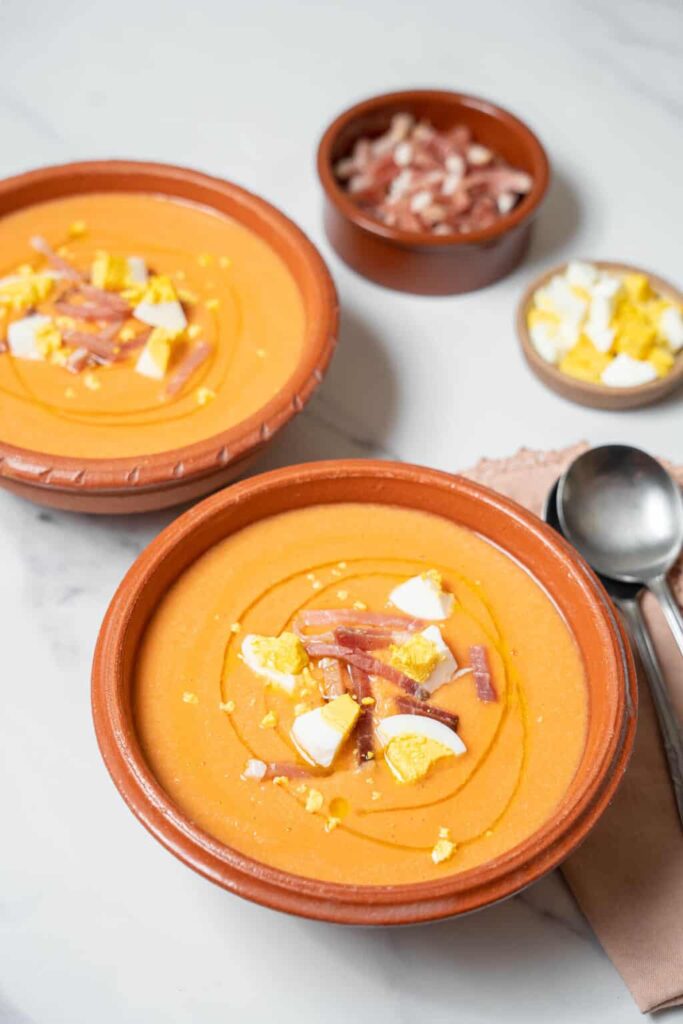
14) Salmorejo
Salmorejo is a chilled tomato soup from the Spanish region of Andalusia. It’s thicker and creamier than gazpacho. This simple dish is perfect for hot summer days.
To make Salmorejo, start by blanching tomatoes in boiling water for about 30 to 60 seconds. Once cooled in ice water, peel and core them.
Add the peeled tomatoes to a blender along with bread, garlic, olive oil, and sherry vinegar. Season with salt and pepper. Blend until smooth and creamy, similar to the texture of yogurt.
If the soup is too thick, thin it with a bit of cold water. Chill the mixture for at least two hours to let the flavors meld.
Serve Salmorejo cold, garnished with chopped hard-boiled eggs and Spanish ham. The rich and creamy texture, combined with refreshing tomato flavor, makes it a delightful appetizer or main course.
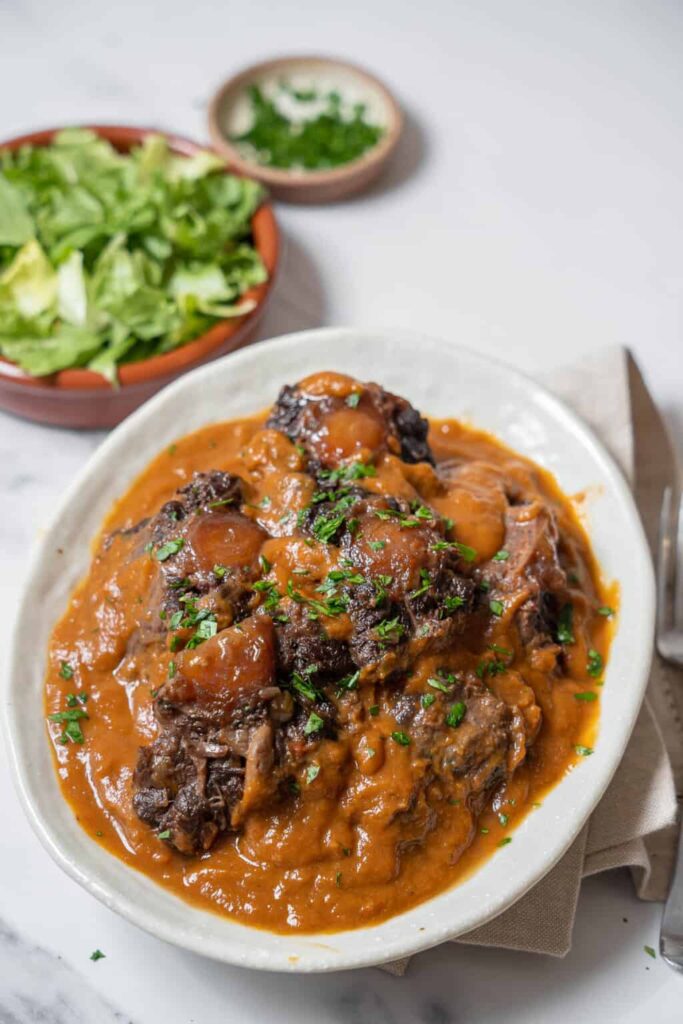
15) Rabo de Toro
Rabo de Toro, or bull tail stew, is a classic Spanish dish. You often find it in the southern region of Andalusia. It’s slow-cooked until the meat is tender and falling off the bone.
Start with oxtail, dusted lightly with flour, salt, and pepper. Brown it in a large pot with olive oil over medium-high heat. This helps to seal in the flavor.
Add onions, garlic, carrots, and tomatoes. Sauté them until they start to soften. This mixture forms the base of your stew.
Pour in red wine and beef stock, enough to cover the meat. Bring it to a boil, then reduce to a simmer. Cover and cook for 3-4 hours. Check occasionally and add more liquid if needed.
The long cooking time allows the flavors to mix, resulting in a rich, hearty dish. Rabo de Toro is often served with mashed potatoes or crusty bread to soak up the sauce.
Enjoy this dish at room temperature or slightly warmed. The deep, savory flavors make it a popular comfort food, perfect for a family meal or special occasion. This recipe lets you bring a bit of Spanish culture into your kitchen.
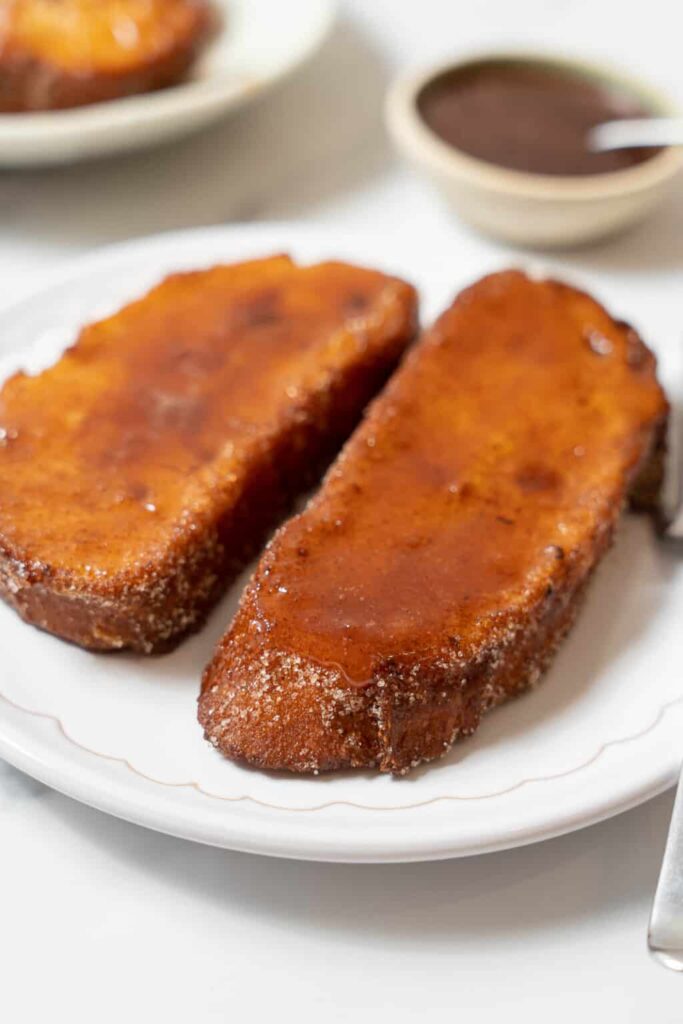
16) Torrijas
Torrijas are a traditional Spanish treat, similar to French toast. They have been enjoyed for centuries and are especially popular during Holy Week.
To make torrijas, start with stale bread. Stale bread soaks up more liquid and holds its shape better when fried. Classic recipes use milk flavored with vanilla and cinnamon.
Dip the bread slices into the milk mixture, allowing them to soak for a few seconds. Then, coat each slice in beaten eggs. This helps create a crispy, golden exterior when fried.
Heat vegetable oil in a skillet to about 180ºC (350ºF). Fry the soaked bread until it becomes golden brown on both sides. Transfer the finished torrijas to paper towels to drain excess oil.
For the finishing touch, coat the fried slices in a mixture of cinnamon and sugar. Some recipes also recommend drizzling the torrijas with honey or a sweet syrup. This adds extra flavor and sweetness to the dish.
Serve the torrijas warm, and enjoy this delicious Spanish favorite.
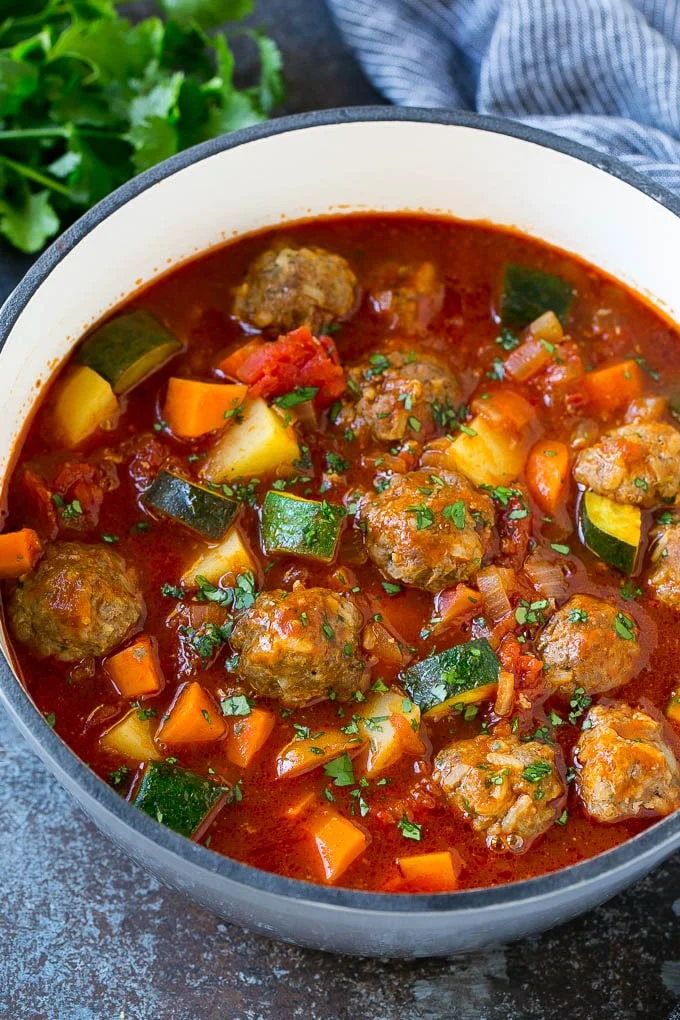
17) Albondigas
Albondigas are Spanish-style meatballs, often served in a rich sauce. They combine ground meats like beef and pork with flavorful spices.
To make the meatballs, mix ground beef and pork with onions, garlic, cumin, paprika, parsley, egg, and breadcrumbs. Shape the mixture into balls about the size of a golf ball.
Heat olive oil in a pan over medium-high heat. Fry the meatballs until they are evenly browned on all sides.
For the sauce, sauté onions in the same pan. Add crushed tomatoes, beef stock, paprika, and a splash of wine. Simmer until thickened.
Place the meatballs back into the sauce and simmer for about 20 minutes. This allows the flavors to meld together.
Serve Albondigas hot, often as a tapa or a main dish with crusty bread.
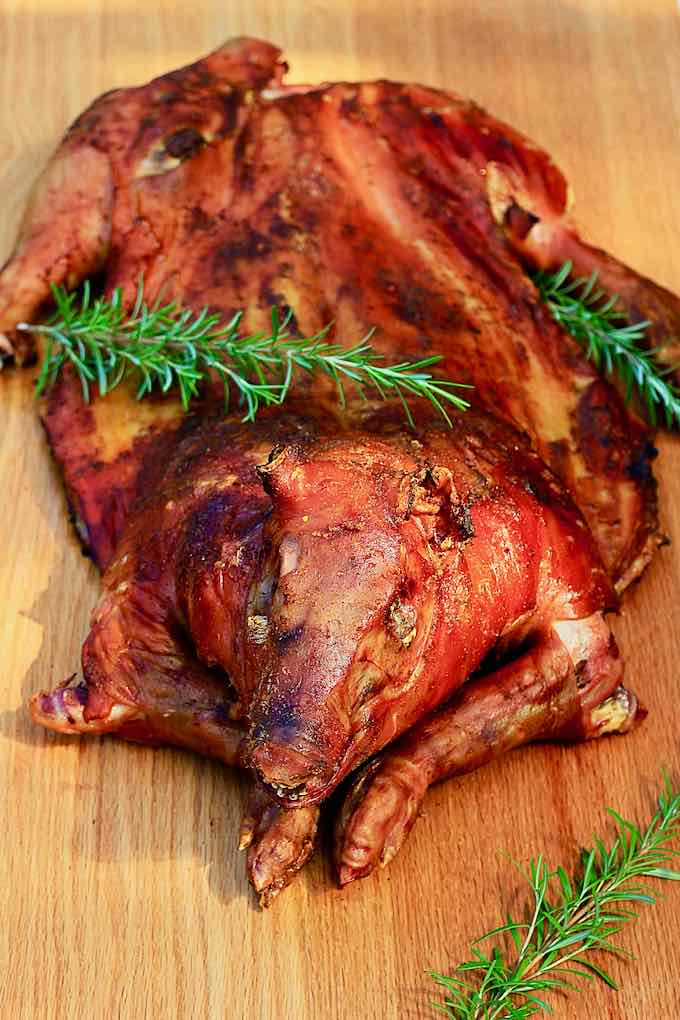
18) Cochinillo Asado
Cochinillo Asado, or roast suckling pig, is a famous Spanish dish known for its tender and flavorful meat. The key to this recipe is using a young pig, usually 6-7 pounds, to ensure the meat is juicy and tender.
To begin, preheat your oven to around 300°F (150°C). Flatten the pig with a mallet, then prick the skin and head with a large needle or fork. This helps to create a crispy skin.
Rub the entire pig with lard and salt. Place it in a large, open roasting pan. Adding a few dabs of butter can enhance the flavor. Roast the pig for about 2.5 hours, basting regularly with the pan drippings to keep the meat moist.
You can add vegetables like carrots and onions to the pan for extra flavor. Season these with salt and pepper and place them around the pig. This will create a flavorful base for your dish.
When the skin is golden and crispy, and the meat tender, your Cochinillo Asado is ready to serve. This dish is a centerpiece of Spanish cuisine and will impress any dinner guest with its traditional and rich flavors.

19) Pulpo a la Gallega
Pulpo a la Gallega is a traditional Spanish dish from Galicia. It’s made with octopus and simple seasonings. This dish is known for its tender texture and rich flavors.
Start by boiling a large pot of salty water. Add the octopus and cook for about an hour, or until tender. To check if it’s done, insert a knife where the legs meet the head. If it goes in easily, the octopus is ready.
Let the octopus cool slightly before slicing. Cut the tentacles and potatoes into half-inch-thick slices. Arrange these on a wooden plate for a traditional touch.
Top the dish with sea salt, smoked paprika, and extra virgin olive oil. These ingredients enhance the octopus’s flavor and give it a classic Galician taste. Serve it warm and enjoy the savory, smokey, and slightly spicy flavors.
Pulpo a la Gallega is a great way to experience authentic Spanish cuisine. It’s simple yet flavorful, making it a standout dish in any Spanish meal.
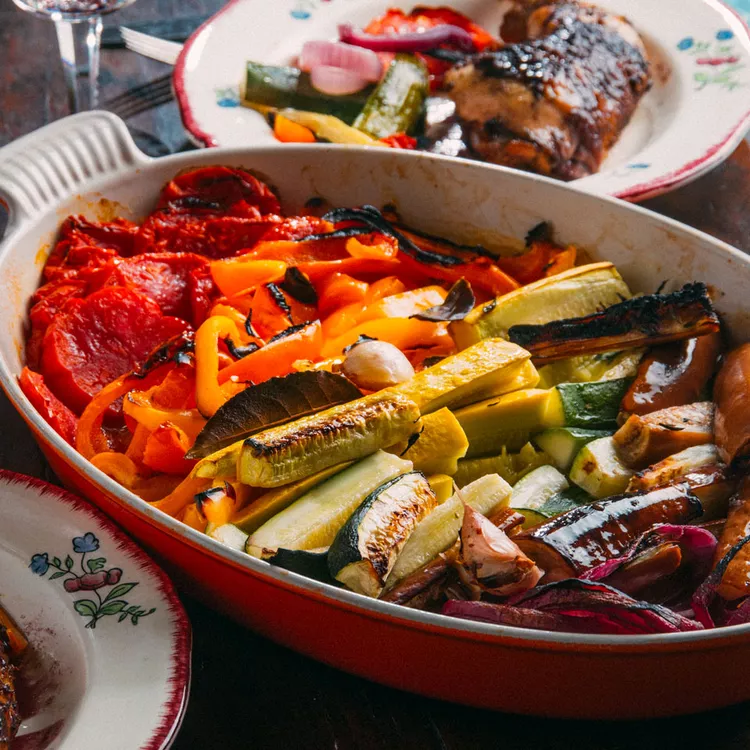
20) Escalivada
Escalivada is a classic Catalan dish made from roasted vegetables. It often features eggplant, red bell peppers, onions, and tomatoes. This dish is known for its smoky flavor and tender texture.
To make escalivada, you first need to preheat your oven to around 450°F (230°C). Wash and dry the vegetables thoroughly.
Place the eggplant, bell peppers, onions, and tomatoes on a baking sheet. Drizzle them with olive oil and sprinkle a bit of salt. You can pierce the peppers and cut the eggplants in half for better roasting.
Roast the vegetables until they are soft and slightly charred. This usually takes about one to two hours. Once done, let them cool for a bit so you can handle them easily.
After cooling, peel the skins off the vegetables. Cut them into strips and drizzle with more olive oil. A touch of salt and pepper enhances the flavors further.
Serve your escalivada warm or at room temperature. It can be a great side dish or a topping for toast. This dish is a wonderful addition to any tapas menu. It highlights the simplicity and rich flavors of Catalan cuisine.
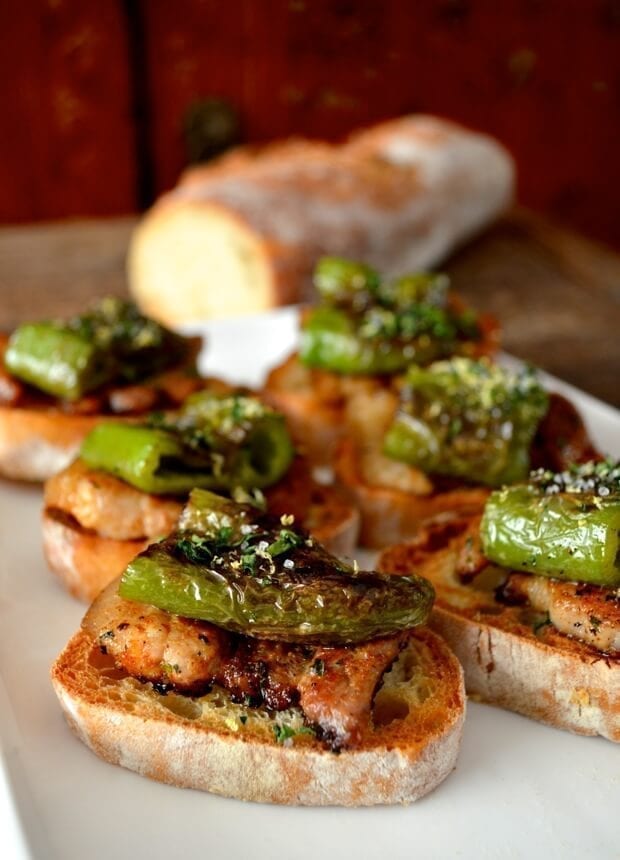
21) Pintxos
Pintxos are small snacks that originated in the Basque Country in Spain. They are similar to tapas but usually skewered with a toothpick.
One popular pintxo is the Classic Gilda. This snack combines Spanish anchovies, Manzanilla olives, and pickled guindilla peppers. Simple yet flavorful, it’s a must-try.
Garlic shrimp pintxo is another crowd-pleaser. For this recipe, cook shrimp with garlic in olive oil. Serve it on a small piece of bread.
Tuna-stuffed piquillo peppers also make a delicious pintxo. These sweet peppers are filled with a savory tuna mixture. They are perfect for a quick bite.
Goat cheese and caramelized onion pintxo is a treat for cheese lovers. Spread creamy goat cheese on bread and top it with sweet caramelized onions.
Making pintxos is a fun way to bring the flavors of Spanish cuisine into your kitchen. Experiment with different ingredients and enjoy!
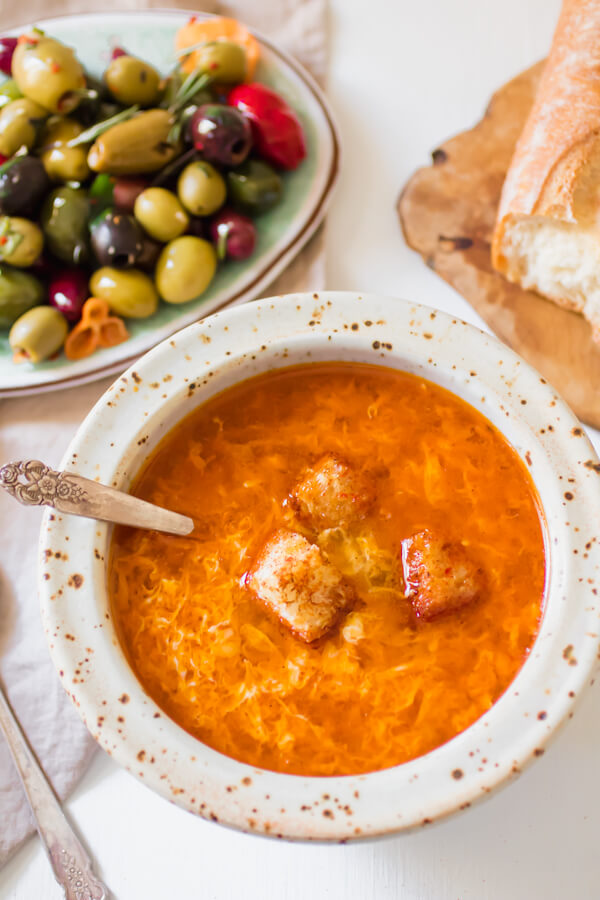
22) Sopa de Ajo
Sopa de Ajo, or Spanish Garlic Soup, is a simple yet flavorful dish. It’s perfect for cold days and easy to prepare.
You start by heating olive oil in a pot over medium heat. Add chopped garlic and cook until it turns golden. This releases the rich garlic flavor.
Next, you add ham and cook for about a minute. Stir in paprika to add a smoky touch. Toss in chunks of stale bread, coating them with the oil and garlic.
Pour in chicken broth to create the base of the soup. Stir well and bring the mixture to a simmer. Let it cook until the bread softens and begins to dissolve.
For a traditional touch, crack eggs into the simmering soup. Stir gently to create a whirlpool effect, which helps cook the eggs.
Your Sopa de Ajo is now ready. Serve it hot. This soup is both comforting and nourishing, showcasing the depth of Spanish culinary tradition.

23) Leche Frita
Leche Frita, or Spanish Fried Milk, is a delicious dessert from Spain. It involves cooking milk with sugar, cinnamon, and lemon peel until it thickens.
After the mixture cools, it is cut into squares, coated in breadcrumbs, and fried until golden brown. The result is a creamy, crunchy treat.
To start, you will need milk, sugar, cornstarch, cinnamon sticks, and lemon peel. Heat the milk with the cinnamon and lemon peel. Let it infuse for a few minutes.
Next, dissolve cornstarch in some milk. Combine it with the hot milk mixture, then cook until thickened. Pour this mixture into a greased dish and let it cool.
Once set, cut the thickened milk into squares. Coat each square with flour, egg, and breadcrumbs. Fry in hot oil until crispy and golden.
Serve your Leche Frita with a dusting of sugar and cinnamon. For an extra treat, add a scoop of ice cream on the side.
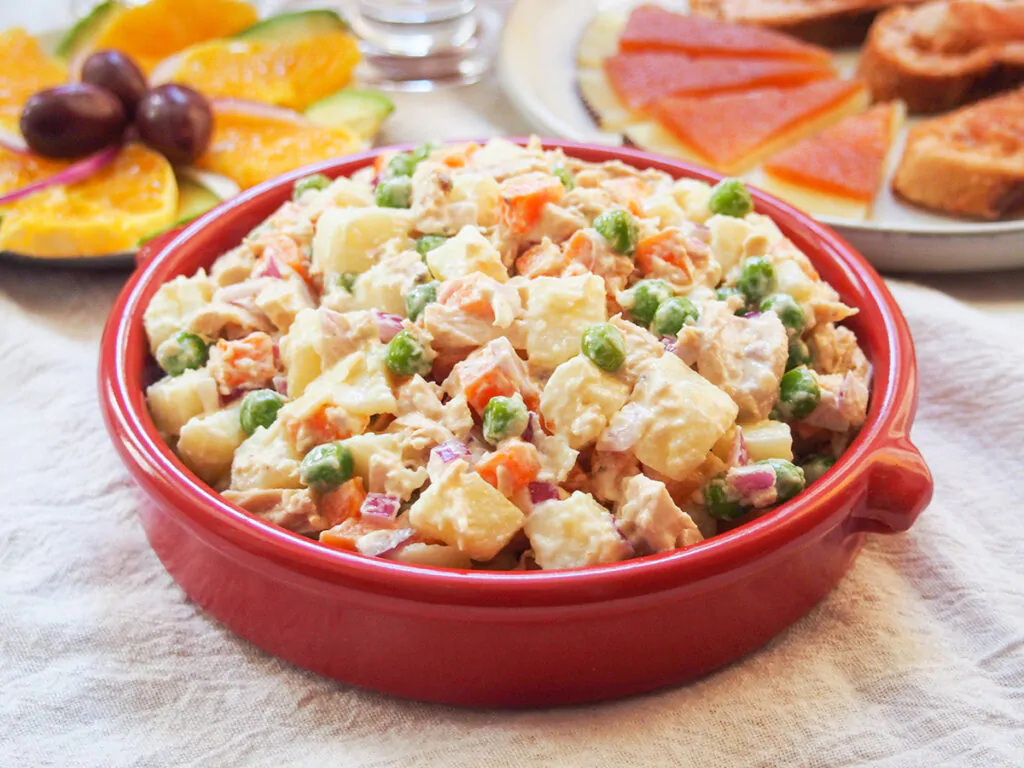
24) Ensaladilla Rusa
Ensaladilla Rusa is a beloved Spanish dish, often enjoyed as a tapas option or a side dish. This classic potato salad has roots in Russian cuisine but has been adapted to fit Spanish tastes.
You start by peeling and cutting potatoes and carrots into small pieces. Boil them in salted water until tender.
Meanwhile, hard boil some eggs. Once cooked, peel and chop them. You can also add peas for more texture and flavor.
Mayonnaise is the key dressing for this salad. Mix it thoroughly with the boiled vegetables and eggs. Ensure everything is well-coated.
For extra flavor, consider adding chopped olives and roasted red peppers. These additions give the salad a Spanish twist.
Refrigerate for a few hours before serving. This allows the flavors to meld together nicely.
Enjoy Ensaladilla Rusa cold, garnished with a bit more chopped egg and olives for presentation. It’s a simple yet delicious addition to any meal.
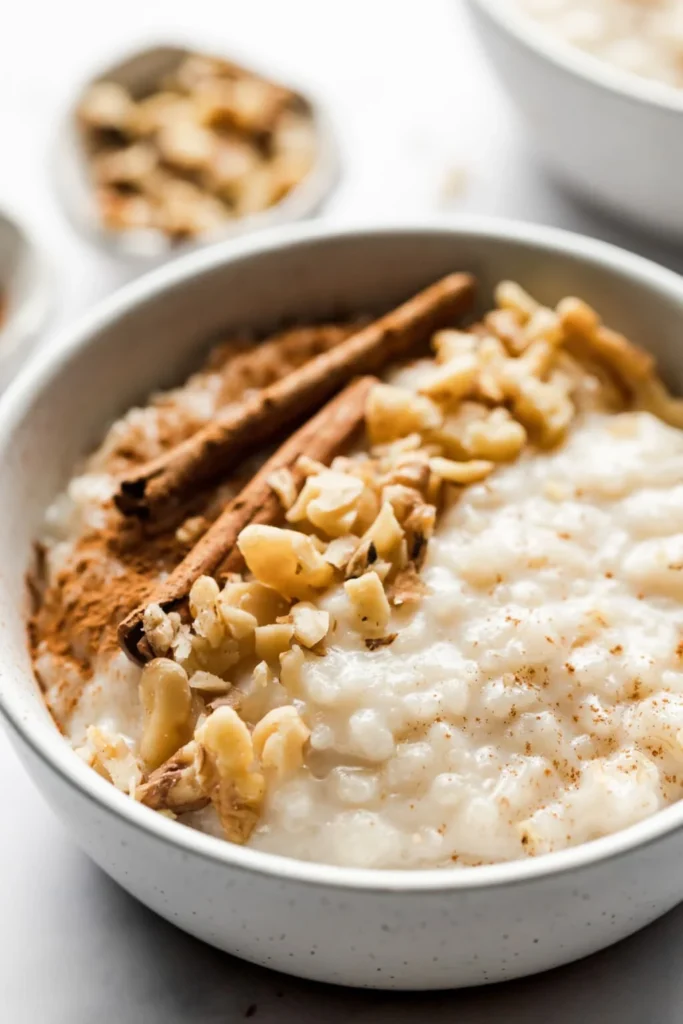
25) Arroz con Leche
Arroz con Leche is a creamy and comforting Spanish rice pudding. This dessert is made with simple ingredients like rice, milk, sugar, and cinnamon.
Start by rinsing the rice until the water runs clear. This helps remove excess starch. In a large pot, bring the rice to a boil with water, cinnamon, and citrus peels like lemon or orange.
Once boiling, reduce the heat to a simmer and cook until the rice is soft. Stir often to prevent sticking. Gradually add milk, about ½ cup at a time, allowing it to absorb before adding more.
After the rice has absorbed all the milk, remove the citrus peels and cinnamon stick. Stir in sugar until it dissolves completely. This makes the pudding sweet and flavorful.
You can serve Arroz con Leche warm or chilled. Some people like to sprinkle a bit of cinnamon on top before serving. You might also add raisins or a dash of vanilla for extra flavor.
This dish is perfect for any occasion, from festive gatherings to a simple family treat. Enjoy your Arroz con Leche as a delightful taste of Spain!
The Basics of Spanish Cuisine
Spanish cuisine is rich and diverse, featuring distinctive ingredients and methods of cooking that bring out bold flavors in its dishes.
Essential Ingredients
Some essential ingredients you’ll find in Spanish cuisine are olive oil, garlic, tomatoes, and saffron. Olive oil is commonly used in cooking and as a dressing. Garlic provides a strong base flavor for many dishes. Tomatoes are used in sauces like sofrito, as well as in fresh salads.
Saffron is a key spice that gives dishes like paella their unique color and flavor. Paprika (especially the smoked variety) adds depth to many recipes such as chorizo and patatas bravas. Jamón serrano, a type of cured ham, is often thinly sliced and served in tapas. Fresher ingredients include peppers, onions, and a variety of seafood such as shrimp and squid.
Typical Spanish Cooking Techniques
Spanish cooking techniques vary but are known for their ability to highlight the natural flavors of the ingredients. Sautéing and frying are common methods, utilizing olive oil to enhance the taste. For dishes like tortilla de patatas (Spanish omelette), potatoes and onions are fried before being added to beaten eggs and cooked into a thick omelette.
Slow cooking and braising are key when preparing stews like cocido and fabada asturiana, allowing the flavors to meld over time. Grilling is popular for dishes like espadines (sardines) and various cuts of meat. Cooking with pans like paelleras for paella ensures even cooking and proper texture.
These techniques, along with grilling, roasting, and using clay pots, create the distinct taste profile of Spanish cuisine.
Regional Variations in Spanish Recipes
Spanish cuisine is known for its rich diversity, with each region contributing unique flavors and dishes. From the warm spices of Andalusia to the coastal inspirations of Galicia, understanding these regional specialties can enhance your culinary experience.
Andalusian Delicacies
Andalusia boasts a cuisine that’s light and fresh. One of the most famous dishes is Gazpacho, a cold tomato soup that’s perfect for hot summers. The region is also known for Pescaíto Frito, little fried fish usually enjoyed as street food.
Tapas originated here, offering a variety of small dishes such as tortilla española and salmorejo. Olive oil is a staple ingredient, giving dishes a distinct flavor. Flamenquín, a breaded roll of pork stuffed with ham, is another hearty favorite in this area.
Catalan Specialties
Catalan cuisine is characterized by its use of fresh, high-quality ingredients. Escalivada is a popular dish made from grilled vegetables like eggplant and red peppers. Pa amb tomàquet, bread rubbed with ripe tomatoes and drizzled with olive oil, is a traditional starter.
Fideuà is a seafood dish similar to paella but made with noodles instead of rice. Calçots are a type of green onion grilled and often served with a thick romesco sauce. Desserts like crema catalana, a Catalan take on crème brûlée, reflect the region’s sweet tooth.
Galician Flavors
Galicia, located in northwest Spain, is known for its seafood. Pulpo a la Gallega (Galician-style octopus) is a must-try, typically seasoned with olive oil, paprika, and salt. The region also excels in empanadas, particularly those filled with fish or seafood.
Lacón con grelos is a traditional dish that combines pork shoulder with turnip tops, reflecting the rustic nature of Galician cuisine. Percebes, or goose barnacles, are a coastal delicacy enjoyed by seafood lovers. The region is also known for Queimada, a strong alcoholic drink often served at celebrations and poured over a sugar cube before being set on fire.
Each region in Spain offers a unique culinary experience, showcasing local ingredients and traditional cooking methods that have been passed down through generations. Exploring these regional dishes will give you a deeper appreciation for Spanish cuisine.
Health Benefits of Spanish Cuisine
Spanish cuisine offers many health benefits due to its wide variety of fresh and nutritious ingredients.
Olive Oil: This staple of Spanish cooking is rich in healthy fats that can lower bad cholesterol. Olive oil is also linked to reduced risks of heart disease.
Fresh Vegetables: Tomatoes, peppers, and onions are commonly used. They provide essential vitamins and antioxidants that support overall well-being.
Lean Proteins: Chicken, fish, and legumes are often part of meals. These proteins help maintain muscle health and are lower in unhealthy fats.
Whole Grains: Spanish dishes often include rice and whole-grain bread. Whole grains are a good source of fiber, which aids digestion and helps control blood sugar levels.
Nuts and Seeds: Almonds and other nuts are common in Spanish recipes. They offer healthy fats and proteins, which can improve heart health.
Seafood: Rich in omega-3 fatty acids, seafood like prawns and fish are beneficial for brain and heart health.
Spices: Saffron and cumin add flavor without the need for additional salt. These spices can offer anti-inflammatory and digestive benefits.
A typical Spanish diet focuses on natural, unprocessed foods. By including a variety of fresh fruits, vegetables, lean meats, and whole grains, Spanish cuisine supports a balanced and healthy lifestyle.








